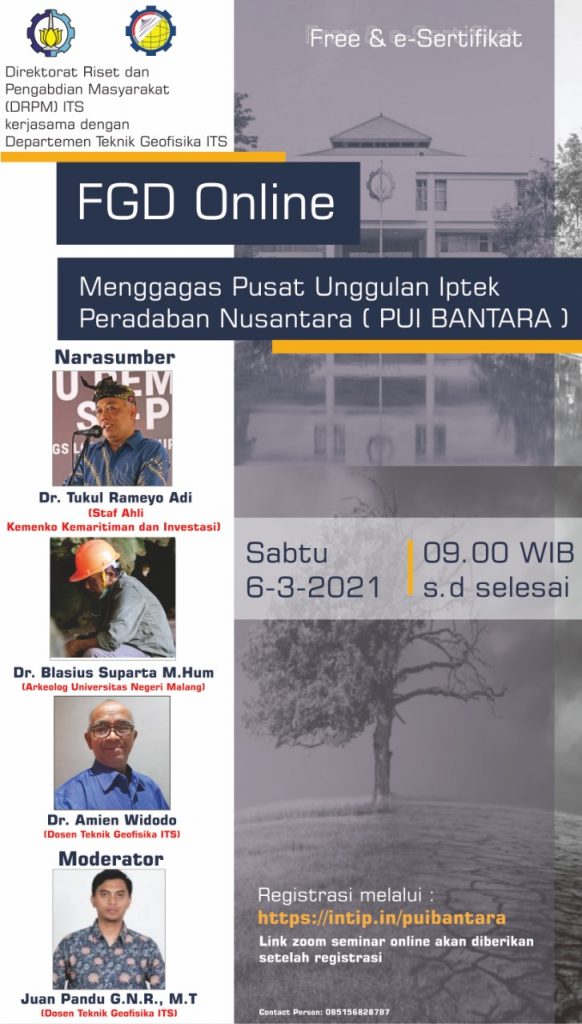Online FGD: Menggagas Pusat Unggulan Iptek Peradaban Nusantara
Information
The Center for Excellence in Science and Technology (PUI) is an organization that has been established at least the last 3 (three) years, both independently and in collaboration with other organizations (consortiums) that carry out international-standard research activities in specific fields in multi-disciplinary and interdisciplinary ways with very high standard results and very relevant to the needs of science and technology users.
The purpose of developing the Science and Technology Center of Excellence is to increase the capacity and capability of R & D institutions to become internationally superior R&D institutions in specific priority areas so that there will be increased relevance and productivity and utilization of science and technology in the production sector to grow the national economy and have an impact on improving the welfare of the community.
We, the archipelago civilization study group will initiate the formation of PUI Pergawai Nusantara in collaboration with many parties. The hope is that we will find genuine scientists and can be used as a foothold for current and future scientists.
Hence, Center of Research and Community Service in collaboration with Geophysical Engineering Department ITS presents:
Online FGD: Menggagas Pusat Unggulan Iptek Peradaban Nusantara
which will be held on:
- Day/Date: Saturday 6 March 2021
- Time: 09.00-drop
With Speakers:
- Dr. Tukul Rameyo Adi (Staf Ahli Kemenko Kemaritiman dan Investasi)
- Dr. Blasius Suparta M.Hum ( Archeologist of Universitas Negeri Malang)
- Dr. Amien Widodo (Researcher and Lecturer of Geophysical Engineering ITS)
and Moderator:
- Juan Pandu Gya Nur Rochman, M.T.(Researcher and Lecturer of Geophysical Engineering ITS)
Presentation of Speakers could be downloaded through the following link:
- Mengupas Pusat Unggulan Ipteks Peradaban Nusantara (Dr. Amien Widodo)
- Sain Dan Teknologi Peradaban Nusantara (Dr. Blasius Suparta M.Hum)
- Literasi Maritim (Dr. Tukul Rameyo Adi)
Register yourself to join the FGD via this link: https://intip.in/puibantara, and get the e-certificate!
#GeophysicalEngineeringITS
#TeknikGeofisikaITS
#FakultasTeknikSipilPerencanaanDanKebumianITS
#FacultyofCivilPlanningAndGeoEngineeringITS
#InstitutTeknologiSepuluhNopember
Latest News
-
Pertajam Keilmuan Petrofisikamu dengan Studi Kasus Di Dunia Oil and Gas, dalam PETROPHYSICS TRAINING 2025!
Teknik Geofisika ITS mengajak anda untuk mendalami pengetahuan dan masalah-masalah yang terjadi seputar Petrofisika dalam acara PETROPHYSICS TRAINING 2025.
-
Kuliah Tamu “Bahaya Geologi Penurunan Tanah Daerah Pesisir Pantai Utara Jawa”
Teknik Geofisika ITS menyelenggarakan Kuliah Tamu “Bahaya Geologi Penurunan Tanah Daerah Pesisir Pantai Utara Jawa” dengan mengundang narasumber dari
-
WEBINAR “CERITA SUKSES UGG KEBUMEN & UGG MERATUS”
Teknik Geofisika ITS dan Ikatan Ahli Geologi Indonesia (IAGI) menyelenggarakan webinar “Cerita Sukses UGG Kebumen dan UGG Meratus”, mengundang






